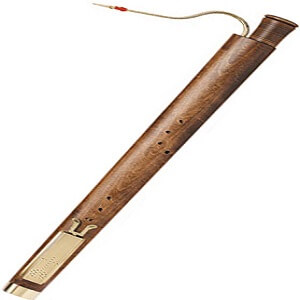Dulcian
 The dulcian is an end-blown conical-bore double-reed aerophone developed and used throughout Europe in the 16th and 17th centuries. Like many other types of aerophones and chordophones of that time, the dulcian was manufactured in several sizes/ranges and for playing in homogeneous groups or consorts. The dulcian pictured here, which is a replica instrument made in the late 20th century, is a bass (also called Choristfagott and Doppel Corthol) and is believed to have been the most common and widely used member of the consort. Like many aerophones of the Renaissance and early Baroque eras, the dulcian, and especially a set of dulcians, was an expensive item more likely to be owned by royalty and aristocrats for performance by court musicians than by amateurs.
The dulcian is an end-blown conical-bore double-reed aerophone developed and used throughout Europe in the 16th and 17th centuries. Like many other types of aerophones and chordophones of that time, the dulcian was manufactured in several sizes/ranges and for playing in homogeneous groups or consorts. The dulcian pictured here, which is a replica instrument made in the late 20th century, is a bass (also called Choristfagott and Doppel Corthol) and is believed to have been the most common and widely used member of the consort. Like many aerophones of the Renaissance and early Baroque eras, the dulcian, and especially a set of dulcians, was an expensive item more likely to be owned by royalty and aristocrats for performance by court musicians than by amateurs.
It is known to have been played in shawm ensembles of the era, which likewise consisted of court musicians most of whom doubled on a number of instruments, and to have been used to support the bass line in polyphonic choral singing. In the 1630s a solo literature for this instrument began to accrue, and throughout much of the 17th century it was used as a bass line instrument in chamber music (see Baroque Trio Sonata for examples of this practice). In the 20th century there was an early music revival during which replicas of Baroque period instruments, and eventually Renaissance ones as well, were once again in demand. Dulcians are played today by amateur enthusiasts, college students in early music ensembles, and a small number of professional concert and recording artists.
The dulcian is a double-reed instrument with a folded conical bore that doubles back on itself by way of a tight U-shaped turn at its bottom end. It is constructed from a single shaft (with an oval cross-section) of wood (often maple) with two parallel bores drilled side-by-side from top to bottom. A brass-covered cap at the bottom of the shaft provides the curved connection between the two bore openings, resulting in a single continuous conical bore that is twice the length of the instrument itself. One end of a detachable, conical brass tube (called a bocal or a crook) that has a hook-shaped bend given to it is wrapped with a thin layer of cork and inserted into a countersunk hole at the top of the narrower bore hole; this tube serves as the top end of the instrument’s conical bore. The wider terminus of the instrument’s bore is topped off with one of two short bells that are connected to the body with a socket-and-tenon joint. The one attached to the instrument in the photo is open at the top, while the second one (seen at the bottom right) has a perforated cap that slightly mutes the sound of the instrument. The instrument has seven fingerholes (six is more common), two thumbholes (located on the reverse side), and two further tone holes covered with padded brass keys (both enclosed with perforated brass boxes, one on the front side, the other on the backside). Most of the fingerholes are drilled at acute angles so that they intersect with the bore at the appropriate acoustical point while keeping the gaps between their surface openings reachable by the player’s fingers. The instrument's double reed made of cane is slid over the end of the bocal.